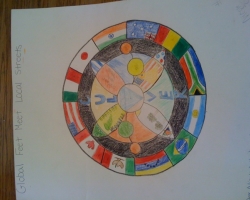
What do you get when two innovative teachers from different schools commingle their students with instructions to adapt an ancient religious/meditative symbol by melding individual concepts of community, while adhering to geometric principles? Answer: the mandala project – the brainstorm of Kyle King, a geometry teacher at Culver City High School and his fiancée, Mimi Ryan, a teacher at Turning Point School.
Mandalas utilize geometric designs, are used as meditation aids and represent important sacred images in Buddhist and Hindu practices. Originating from a Sanskrit word that generally means “circle,” they are rich with symbolism.
“The project was born out of general talk on education one day while we were hiking,” King explained. “Mimi and I teach different ages and disciplines but have a common philosophy on education. The mandala idea seemed to capture all of this.”
“We were talking about sacred geometry in nature,” Ryan added, “which led to a discussion about mandalas, which then led to the idea of bringing our students together. As the project evolved, we decided to incorporate school, local, national and global communities as the theme for each mandala.”
About 60 students participated, drawn from Ryan’s eighth-grade class and King’s second-period geometry class, meeting at Culver City High. Twelve groups were formed, each joining students from the two schools. King’s students were required to make up any regular geometry class lessons missed so that they would not fall behind.
“Geometry at Culver City High is mostly a 9th- and 10th-grade course,” King said. “However, there might be students in the class all the way up to the 12th grade. Geometry is a very inclusive class because most students at Culver City High will take the class. It includes students that are very math-minded and will go on to the highest levels of math and students that are taking it simply for credit. Also, geometry is an interesting math because it is extremely visual, lending itself to kinesthetic learning and involving integrated thought in doing proofs.”
The project was an offshoot of curriculum for King, who introduced mandalas when starting the class’s unit on circles – part of his practice of giving all his geometry classes related projects that allow them to use and get creative with geometry tools such as compass, ruler and protractor.
“These activities incorporated circumferences, radius, area, inscription, conscription, arcs and angles,” he said. “I strongly believe in introducing a unit by letting the students learn and discover on their own terms. My job is to later deliver lessons on the more technical aspects of the concepts.”
Ryan recalled that the first day was a bit “daunting” and many of the students felt quite shy. “They read portrait poems, which allowed them to share about themselves, and this helped spark some conversation,” she said. “The second meeting was easier and students began to bond. We discovered that some had even found each other on Facebook. While some groups connected more than others, it was a friendly, respectful and considerate atmosphere when they collaborated.”
Initially, the students each created their own mandalas dedicated to a specific community (school, local, national, global), which they then shared with their group. The group then determined which elements they wished to include in their collaborative mandala.
As the objective of the project was to create peace and positive energy, students were encouraged to think about issues faced by those communities, such as social injustices, illness, poverty, national disasters, environmental issues and war or the positive aspects of those communities. For example, heroes, learning, nature, growth, positive people and traditions, activists, culture and diversity, art, music, etc. While it was acceptable to represent some of the issues in a dark manner, another part of the process was to create designs that evoked the healing and kindness that the students wished for these issues.
Students used the geometry vocabulary in their written descriptions of their mandalas. At the final session, each small group presented its mandala to the larger group, describing its theme and individual components. A display of the mandalas is currently under discussion.
Asked to reflect on the value of this project, King responded, “Any time you are doing education across boundaries, you are achieving something.” He said that in this case it was most prominently the private/public school line that is being crossed.
“These are all kids that are living in Los Angeles, Culver City and adjacent areas and overlap with one another in society, so it is nice to have that happen here,” he said. “It promotes a more informed and integrated society.”
King said he was “overjoyed” during the presentation of the mandalas to see students that are usually less than participatory taking leadership roles and appreciating the alternative opportunity to do circular geometry. “As a math teacher it is challenging to give all students the opportunity to show their intelligence and participate to their fullest potential,” he said.
Ryan felt the experience was “a good example 21st century education, in that it is project-based, incorporates multiple disciplines, fosters cooperative learning skills and will serve as a globally conscientious art piece for the local community to enjoy.”
She added “This project allowed eighth-grade students to visit a high school, which is good preparation for their upcoming freshman year. On a basic but profound level, it provided a rich experience through math, art, human connection and diversity. Groups were not perfect and some had challenges, while others had a seamless experience. Either way, the experience was authentic and reflected real life.”
Ryan and King enabled their students to think outside the box and cooperate to design communities within their circles, gaining valuable life lessons in so doing.
